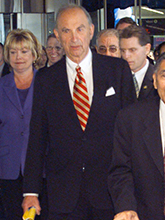
Bay Area Rapid Transit (BART) is a rapid transit system serving the San Francisco Bay Area in California. BART serves 50 stations along six routes and 131 miles of track,including eBART,a 9-mile (14 km) spur line running to Antioch,and Oakland Airport Connector,a 3-mile (4.8 km) automated guideway transit line serving San Francisco Bay Oakland International Airport. With an average of 160,400 weekday passengers as of the fourth quarter of 2023 and 48,119,400 annual passengers in 2023,BART is the sixth-busiest rapid transit system in the United States.

Caltrain is a California commuter rail line serving the San Francisco Peninsula and Santa Clara Valley. The southern terminus is in San Jose at Tamien station with weekday rush hour service running as far as Gilroy. The northern terminus of the line is in San Francisco at 4th and King Street. Caltrain has 28 regular stops,one limited-service weekday-only stop,one weekend-only stop (Broadway),and one football-only stop (Stanford). While average weekday ridership in 2019 exceeded 63,000,impacts of the COVID-19 pandemic have been significant:in August 2022,Caltrain had an average weekday ridership of 18,600 passengers.

The San Francisco Transbay Terminal was a transportation complex in San Francisco,California,United States,roughly in the center of the rectangle bounded north–south by Mission Street and Howard Street,and east–west by Beale Street and 2nd Street in the South of Market area of the city. It opened on January 14,1939 as a train station and was converted into a bus depot in 1959. The terminal mainly served San Francisco's downtown and Financial District,as transportation from surrounding communities of the Bay Area terminated there such as:Golden Gate Transit buses from Marin County,AC Transit buses from the East Bay,and SamTrans buses from San Mateo County. Long-distance buses from beyond the Bay Area such as Greyhound and Amtrak Thruway also served the terminal. Several bus lines of the San Francisco Municipal Railway connected with the terminal.

Millbrae station is an intermodal transit station serving Bay Area Rapid Transit (BART) and Caltrain,located in Millbrae,California. The station is the terminal station for BART on the San Francisco Peninsula,served by two lines:The Red Line before 9 pm and the Yellow Line during the early morning and evening. It is served by all Caltrain services. The station is also served by SamTrans bus service,Commute.org and Caltrain shuttle buses,and other shuttles.
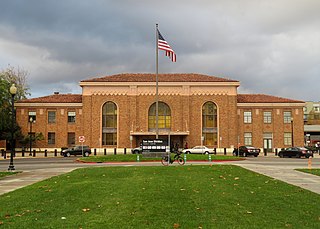
San Jose Diridon station is the central passenger rail depot for San Jose,California. It also serves as a major intermodal transit center for Santa Clara County and Silicon Valley. The station is named after former Santa Clara County Supervisor Rod Diridon Sr.

People in the San Francisco Bay Area rely on a complex multimodal transportation infrastructure consisting of roads,bridges,highways,rail,tunnels,airports,seaports,and bike and pedestrian paths. The development,maintenance,and operation of these different modes of transportation are overseen by various agencies,including the California Department of Transportation (Caltrans),the Association of Bay Area Governments,San Francisco Municipal Transportation Agency,and the Metropolitan Transportation Commission. These and other organizations collectively manage several interstate highways and state routes,eight passenger rail networks,eight trans-bay bridges,transbay ferry service,local and transbay bus service,three international airports,and an extensive network of roads,tunnels,and bike paths.
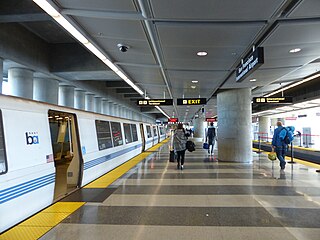
San Francisco International Airport station is a Bay Area Rapid Transit (BART) terminal station located adjacent to Garage G inside the San Francisco International Airport. The elevated station is a transfer point to the AirTrain people mover system at Garage G/BART station.
The San Francisco Transbay development is a completed redevelopment plan for the neighborhood surrounding the Transbay Transit Center site,South of Market near the Financial District in San Francisco,California. The new transit center replaced the since-demolished San Francisco Transbay Terminal,and new skyscrapers,such as Salesforce Tower,took advantage of the height increases allowed through the San Francisco Transit Center District Plan. The sale of several land parcels formerly owned by the state and given to the managing Transbay Joint Powers Authority helped finance the construction of the transit center.

San Francisco 4th and King Street station,also known as the Caltrain Depot,is a train station in the SoMa district of San Francisco,California. It is presently the northern terminus of the Caltrain commuter rail line serving the San Francisco Peninsula and Santa Clara Valley. It is also the eastern terminus of the N Judah and E Embarcadero,as well as a stop along the T Third Street of the Muni network. The station is additionally the projected terminus for the first phase of the California High-Speed Rail project and a station once Phase 2 is completed.

Bayshore station is a Caltrain commuter rail station in the Visitacion Valley neighborhood of San Francisco,California. The station is on the border of San Francisco and the neighboring city of Brisbane. The parking lot and the northern section of the station are in San Francisco,while the remainder is in Brisbane. The station address is in San Francisco proper.

San Bruno station is a Caltrain station located in San Bruno,California. The station is located just northeast of downtown San Bruno,above the intersection of San Mateo and San Bruno Avenues,adjacent to Artichoke Joe's Casino.
Throughout the history of Bay Area Rapid Transit,there have been plans to extend service to other areas.
Bay Area Rapid Transit,widely known by the acronym BART,is the main rail transportation system for the San Francisco Bay Area. It was envisioned as early as 1946 but the construction of the original system began in the 1960s.

The Transbay Transit Center is a transit station in downtown San Francisco. It serves as the primary bus terminal for the San Francisco Bay Area,and is proposed as a possible future rail terminal. The centerpiece of the San Francisco Transbay development,the construction is governed by the Transbay Joint Powers Authority (TJPA). The 1,430-foot-long (440 m) building sits one block south-east of Market Street,a primary commercial and transportation artery.

The Southern Crossing is a proposed highway structure that would span San Francisco Bay in California,somewhere south of the San Francisco–Oakland Bay Bridge and north of the San Mateo–Hayward Bridge. Several proposals have been made since 1947,varying in design and specific location,but none of them have ever been implemented because of cost,environmental and other concerns.
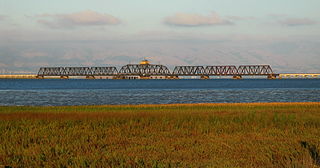
The Dumbarton Rail Corridor is a proposed transbay passenger rail line which would reuse the right-of-way that was initially constructed from 1907–1910 as the Dumbarton Cut-off. The Dumbarton Cut-off includes the first structure to span San Francisco Bay,the 1910 Dumbarton Rail Bridge,although the vintage Cut-off bridges would likely be replaced prior to activating new passenger service. Dumbarton Rail Corridor would provide service between Union City in the East Bay and Menlo Park on the Peninsula,with train service continuing to both San Francisco and San Joséalong the existing Caltrain tracks. It has been in the planning stages since 1988,and would be the first above-ground transbay rail line since Key System electric trains stopped running on the lower deck of the Bay Bridge in 1958,and the first new transbay crossing of any kind since the completion of the Transbay Tube in 1974.

The Caltrain Express (CTX) project was implemented from 2002 to 2004 and led to the establishment of the Baby Bullet express service,which shortened the transit time between San Francisco and San Jose,and certain stations in between. New locomotives and rolling stock were purchased for dedicated express service,bypassing most stations;quad-track overtake sections were added in two locations along the Peninsula Corridor right-of-way to allow express trains to pass slower local trains that were making all stops;tracks were also upgraded with continuous-welded rail;a centralized traffic control system was added;and crossovers were added every few miles to allow single-tracking trains around disabled trains. Congresswoman Jackie Speier,then serving as a California State Senator,is credited with securing the funding for CTX and one of the new locomotives acquired for the project is named for her as a result. During commute hours,the Baby Bullet is up to 20% faster than driving south from San Francisco to San Jose.
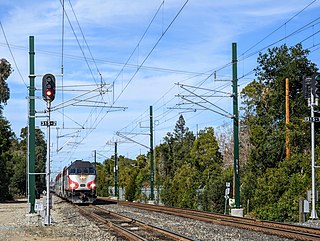
The Caltrain Modernization Program (CalMod),sometimes referred to as the Caltrain Electrification Project,is a $2.44 billion project that will add a positive train control (PTC) system and electrify the main line of the U.S. commuter railroad Caltrain,which serves cities in the San Francisco Peninsula and Silicon Valley,as well as transition from its current diesel-electric locomotive powered trains to electric multiple units (EMU). According to Caltrain,electrification of the tracks will allow it to improve service times via faster acceleration and shorter headways,reduce air pollution and noise,and facilitate a future railway tunnel into downtown San Francisco's Transbay Transit Center,as diesel trains cannot serve underground stations.

The Downtown Rail Extension (DTX),officially branded as The Portal,is a planned second phase of the San Francisco Transbay Transit Center (TTC). When complete,it will extend the Caltrain Peninsula Corridor commuter rail line from its current northern terminus at 4th and King via a 1.3-mile (2.1 km) tunnel. The new terminus will be near the Financial District and will provide intermodal connections to BART,Muni,Transbay AC Transit buses,and long-distance buses. In addition,the California High Speed Rail Authority (CHSRA) plans to use DTX and the Caltrain-owned Peninsula Corridor for service on the CHSRA San Francisco–San Jose segment. Because DTX uses a long tunnel,current diesel locomotives are not suitable and the Caltrain Modernization Project (CalMod),which includes electrification of the line and acquisition of electrified rolling stock,is a prerequisite.
